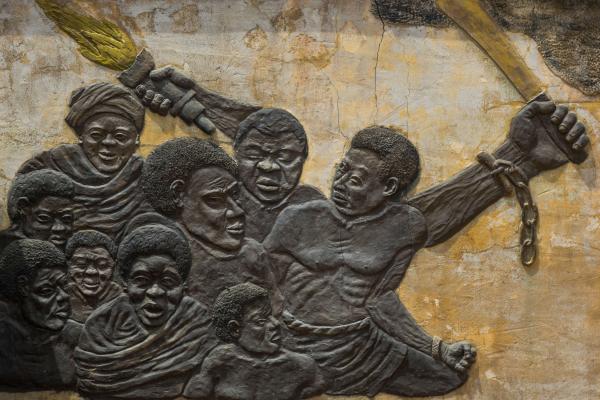Recently, a report from Public Religion Research Institute (PRRI) found that Black Protestants are the only Christian group in which a majority — 63 percent — believes that congregations should get involved in social issues even if doing so means having difficult conversations about politics. This tells me that white congregations, in contrast, believe that churches are best left as places of solace, where difficult conversations do not take place. Ultimately, this allows for white supremacy to remain intact within these houses of worship. I am the senior pastor of Lake Street Church of Evanston, a predominantly white church, and our path out of white supremacy has required us to take the lead from Black congregations on a variety of social justice issues.
In Evanston, Ill., Black congregations have taken the lead in conversations about how we can push our community to emphasize justice through concrete action. In a place that sometimes still refers to itself as “Heavenston” — a reference to its godliness and moral rigor — our community has begun to reimagine everything from policing, to reparations for redlining, and how to better protect our Jewish neighbors. Indeed, the pastors of many Black churches in our town have led the push for reparations — with Evanston being the first municipality in the nation to offer reparations to its Black citizens.
One historically Black church has been at the forefront of these conversations. In the wake of the Pulse Nightclub shooting in Florida in 2016, Second Baptist Church hosted the Evanston Interfaith Clergy and Leadership and concerned citizens to discuss the importance of combating violence against the queer community. There were so many community members gathered that they spilled onto the street.
When the police shooting of Jacob Blake happened in nearby Kenosha, Wis., the senior pastor of Second Baptist Church, Rev. Michael Nabors, gathered our community for a service of lament. Similarly, when addressing antisemitic violence after the desecration of a local Jewish cemetery, Nabors rallied the community together to provide a theological response that emphasized the danger of antisemitism in our communities. That leadership offered the opportunity for white congregations in our community to stand in solidarity with victims of violence but we were also invited to mobilize our resources as communities of faith in order to combat antisemtism, anti-queer violence, and create spaces of flourishing for all.
Our world is full of pain and suffering, and white churches have created much of the theology causing that harm. It is white congregations around the country that are supporting gun ownership and tying it to a vision of Christian masculinity that leads to racialized violence across the U.S. Likewise, it is white Christians who are at the center of a growing movement of white Christian nationalism and anti-trans rhetoric and violence.
Responding to these issues can seem daunting. What I’ve found is that doing social justice work alone is impossible and that Black congregations who are involved in social justice initiatives provide indispensable leadership because they have often been engaged in this work for longer than their white counterparts. The problem is that white congregations are used to being the ones who lead and are therefore apprehensive to being led by and accountable to Black churches.
Even when white congregations are willing to be “controversial” by advocating for justice issues, we still make missteps. From my research on the Sanctuary Movement of the 1980s for my forthcoming book, Sanctuary and Subjectivity, I have seen how white activists can lead initiatives that end up compounding the harms that they seek to undo.
For example, despite the measurable good that the Sanctuary Movement accomplished, white sanctuary activists often related to Central American people who were seeking sanctuary in patronizing ways, demanding that, as one activist put it, “our refugees” structure their testimonies to be palatable to white audiences. Many of the recipients of sanctuary were activists who had concerns about a 500-year history of colonialism in Central America that their white supporters did not want to hear. Good intentions are not a talisman to be used to ward off the harms that white congregations can perpetuate, despite our best efforts to do otherwise.
For my congregation, following Black congregational leadership has resulted in a rich partnership with Second Baptist Church. United as sister churches in 2018, we are joined together by a shared history that involves white supremacy and segregated seating. Today, we have charted a shared future based on reparations and social action in our community, developing a coalition to address Evanston’s educational opportunity gap — which is amongst the highest in the nation. Prioritizing the educational gap in Evanston was not suggested by my church but by Second Baptist, as the focus of our work together. We will continue to take the lead from Second Baptist as we are committed to a years-long discernment process that emphasizes accountability for the ways that my congregation has benefited from and perpetuated white supremacy. We are also committed to the necessity of Black leadership. Following the lead of Second Baptist has allowed us to do bold work that we could have never done on our own.
Indeed, it is Black congregations that are leading the charge on a host of justice issues, including work around environmental racism. The local body of my denomination, The American Baptist Churches of Metro Chicago, recently committed to working together to address social issues like the contaminated water crisis in the Chicago neighborhood of University Park, a community where thousands of majority-Black homes lack access to clean drinking water. The fight is being led by the pastor of University Park Baptist Church, Rev. Reginald Williams, who has been working for nearly four years to address the crisis and enforce accountability for Aqua Illinois and its executives, who run the town’s water supply.
Often white congregations like mine do act on environmental issues through things like writing letters or protesting pipelines, which can sometimes be more about feeling good than affecting real change. But more effective activism means taking the lead from Black congregations who have suffered the harms of white supremacy and have been engaged in the struggle for justice for years prior to our involvement.
With the white church’s record on social justice issues being so bleak, white congregations who want to work toward a more just society need to turn to the leadership of Black communities of faith who have been addressing these issues for decades. What white congregations are often missing is a willingness to be led by Black congregations. But if we can move past our own white pride, we might actually find that we can better pursue the gospel.
Got something to say about what you're reading? We value your feedback!







